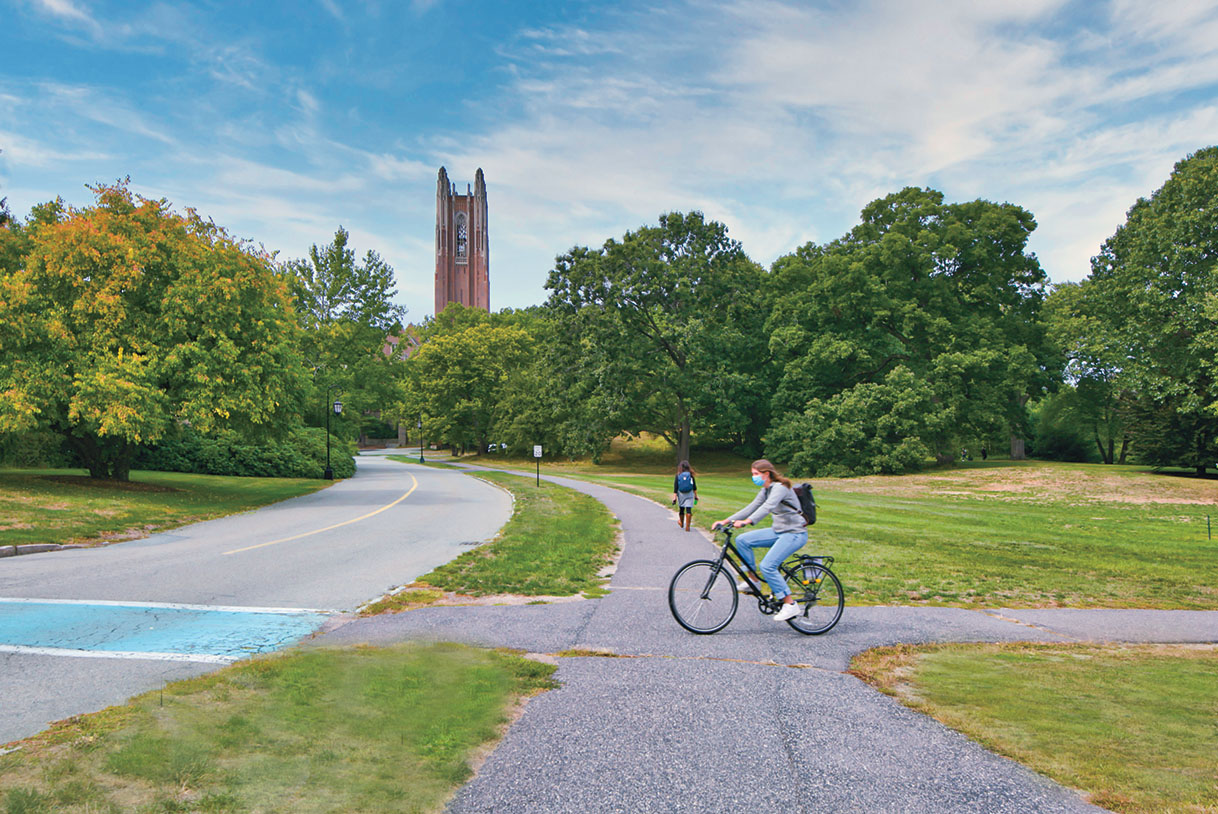Once the decision was made to have students return to campus in the fall, it was all hands on deck as everyone raced to make sure it could happen, and would happen as safely as possible.

‘We Wear Because We Care’
This fall, community members have been expected to wear masks at all times. For students, this meant any time they left their rooms, including while at campus jobs (Audrey Taillon ’23 on the left and Aaliyah Beckford ’23 weed bittersweet in the botanic gardens), in the classroom, and when traveling across campus.
Photo by Lisa Abitbol
Every summer, an enormous amount of work goes into preparing the College for the return of students, from creating a welcome for first-years to updating syllabi to repairing dorm rooms. Add in the effects of a global pandemic, and that workload rockets from enormous to, well, Herculean.
Once the decision was made to have students return to campus in the fall, it was all hands on deck as everyone raced to make sure it could happen, and would happen as safely as possible. “Frankly, a lot of faculty members, myself included, spent pretty much their whole summer figuring out how we were going to teach successfully in this new environment,” says Carla Verschoor, adjunct assistant professor of chemistry.
While faculty grappled with how to adjust and adapt, the Facilities Management department was implementing a three-pronged approach to the changes necessary for buildings to safely welcome occupants again: air quality, distancing, and cleaning. To improve indoor air quality, the department undertook a significant analysis and overhaul of the ventilation systems on campus. Although the College followed the guidance issued by the CDC and the state of Massachusetts, when it came to ventilation, “We made a decision to go above and beyond,” says Dave Chakraborty, assistant vice president of facilities management and planning. The College followed guidance from the American Society of Heating, Refrigerating, and Air-Conditioning Engineers (ASHRAE) to increase air changes from an average of twice an hour to four times an hour, and increased the amount of outside air used from 20–25 percent to 100 percent outside air. “This is done to reduce the viral load in a classroom or a dining setting, where there are a number of people in the room at the same time,” Chakraborty says.

Photo courtesy of Wellesley Communications & Public Affairs
The next area of focus was creating spaces where people could congregate at safe distances. Every classroom was evaluated to determine how many students and faculty it could hold at the appropriate six feet of distance. “The capacity of classrooms was reduced by about 70 to 75 percent,” Chakraborty says. This rendered some classrooms unusable and created the need for new spaces to hold larger classes: The ballroom in Alumnae Hall has been pressed into classroom duty, as has the chapel. Every classroom’s furniture has been carefully placed (on spots marked on the floor) to ensure that appropriate distances are maintained. In residence halls, in addition to all students being in singles, bathroom capacities have also been limited to ensure distancing and appropriate air quality.
The third area of focus for the facilities department is cleaning—perhaps the largest undertaking, since it requires continuous work. Residence halls are now cleaned twice a day, seven days a week, and classrooms are cleaned and disinfected every night. “Our custodial staff grew by almost 50 percent to do this cleaning,” Chakraborty says. “For the first time, we have a night crew that works an overnight shift now to clean the classrooms.” In addition to the cleaning provided, the department also maintains hand sanitizer stations throughout campus, as well as cleaning kits, which house supplies like cleaning wipes, extra masks, etc. “We had a couple of months to hire all the new custodians and get all the assessments completed, in addition to all the work we normally have over the summer anyway,” Chakraborty says. “It was a Herculean effort.” The price tag for all these changes is estimated at $2.2 million.

Photo courtesy of Wellesley Communications & Public Affairs
Similar efforts were put in by the faculty, as they determined how to structure in-person and remote classes. In addition to teaching in masks and other challenges, faculty had to adjust 13-week classes to fit into seven weeks, as semesters were divided into two terms. Classes may meet for longer durations or more frequently, up to as many as six times a week (five lectures plus a laboratory for some science courses). This shortened timeline required major adjustments, which faculty have addressed in a variety of ways, from recording videos for students to watch on their own to decreasing some of the material covered. “This is a very intense experience for them,” Verschoor says. “I’m asking a lot of my students, and so far, they have risen to the occasion.”
Although most on-campus classes are meeting in person, mask-wearing and social distancing present unique challenges to the curriculum, especially for specialized courses like languages or labs. “When you’re picking up a new language, especially a new language very different from English, like Russian, it’s really helpful to be able to see the mouth of the person who is making those strange sounds,” says Thomas Hodge, professor of Russian. The College has provided clear plastic masks to help with this, as well as lapel microphones and other technology to help professors in larger classrooms. Many faculty are utilizing Zoom meetings to do the group work that can’t be done safely in person.
“I’ve loved returning to in-person teaching,” Hodge says. “Even though we have to stay very far apart and we need to be wearing our masks, it’s all worth it, just to be back in that space, going through the adventure of learning together.”